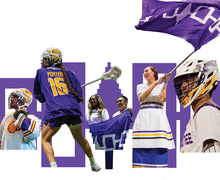Track : Staponkute sets sights on NCAA championships in triple jump
Ieva Staponkute has her sights set on qualifying for the NCAA championships. And that’s an idea that seemed farfetched a year ago.
Staponkute, a junior triple jumper on the Syracuse track and field team, struggled to find her rhythm as a sophomore. Her best triple jump mark during the indoor season was 11.65 meters, good for only a tie for 251st nationally.
But just a year later, she finds herself in position to reach her goal. Staponkute is currently ranked 28th nationally, with a top mark of 12.62 meters. The top 16 marks qualify for NCAAs, and 16th is currently at 12.86 meters, according to the Track and Field Results Reporting System.
Staponkute came from Lithuania to attend Syracuse. Adjusting to the rigors of Division I competition did not come easy at first. It took a couple of years for her to gain the necessary mindset to compete at such a high level, track and field jumps coach Dave Hegland said.
‘When you’re 18 or 19 years old and you come from a different country, things are a little different,’ Hegland said. ‘It takes a while for all that to stabilize.’
Staponkute, who initially considered Division III schools, such as Williams College, before realizing she could compete at a Division I level, struggled to find her rhythm as a sophomore.
Hegland attributed the struggle to inadequate self-discipline.
‘She was more inconsistent in terms of her training habits,’ Hegland said. ‘She would tell you this, too. She missed a lot more practices. She was injured a lot more.’
This season, a few subtle off-the-track changes have put Staponkute in a position to break through and make the NCAAs. Hegland said Staponkute has shown up to train every day well rested and feeling good. And that makes a huge difference.
This is Hegland’s first season as jumps coach at Syracuse, adding on to his previous duties as sprints and hurdles coach. The influence has altered Staponkute’s practice regimen for the better, Hegland said.
‘The one thing she needed a little more work on was sprints,’ Hegland said. ‘It was just a matter of trying to get her a little bit faster, a little bit stronger.’
Staponkute understands the positive effect on this change in approach.
‘We did a lot of sprinting, a lot of running workouts, and that worked really well for me,’ Staponkute said. ‘That’s what I needed, and that’s why I’m jumping farther.’
Even before the refocus on conditioning Hegland brought this year, Staponkute’s potential was obvious. If not, she wouldn’t have competed in triple jump. The event is not easy to take on.
It’s illustrated by the fact that only one other player on the SU women’s team besides Staponkute competes in triple jump at Syracuse.
‘It’s a ton of technique,’ Hegland said. ‘It’s probably the most technical event in our sport.’
Staponkute’s feel for the event, developed both naturally and with help from former coaches, is what sets her apart from most, Hegland said.
‘Some people just get it,’ Hegland said. ‘Some people can shoot a basketball, they can throw a football. She’s got a great innate feel for the event, and her high school coach did an unbelievable job.’
Teammate Victor Nwosu, who competes in both long jump and triple jump and has trained with Staponkute for three years, continues to be amazed with her talent.
Aside from the physical benefits of focusing more on sprinting and conditioning, Staponkute is also more confident in the results her new training will provide.
‘She believes in the workouts more,’ Nwosu said. ‘It’s been two different styles, and this is more comfortable for her.’
Staponkute’s top mark of 12.62 meters currently leads the Big East by 0.2 meters over Charachesicia Lockhart of Louisville, but winning the conference doesn’t guarantee an NCAA appearance, Hegland said.
Hegland feels consistency will ultimately prove pivotal in whether Staponkute can break through and qualify for the NCAAs, which he thinks will require a mark slightly more than 13 meters.
Said Hegland: ‘If she can establish herself as someone who can consistently jump 12.60, 12.70, then when she has a great jump, she can get around 13 meters.’
Published on February 15, 2011 at 12:00 pm
Contact Kevin: kmprisei@syr.edu





